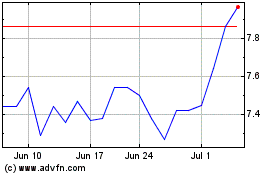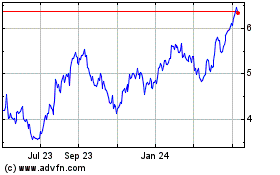By Ryan Knutson
KOSIVSKA POLIANA, UKRAINE -- A team of network technicians in
February ventured into the snow-covered Carpathian Mountains in
southwestern Ukraine, where a pocket of less than 5,000 people live
in a narrow valley.
They made the trek to install a cellphone antenna, and bring the
village online with third-generation, or 3G, wireless service, the
kind of high-speed Internet technology that allows smartphone users
to surf the web, watch YouTube and hail an Uber taxi. For a place
with so few jobs and no tourist attractions, the installation came
as a surprise.
"I was shocked," said Oleksiy Kopusiak, who was sitting at home
listening to music when he noticed the 3G signal appear on his
phone. The 21-year-old construction worker suddenly could stream
music online with no delay. "Everyone is so happy," he said, before
sitting down to celebrate over beers with his friends.
The interest in the tiny hamlet reflects the maturing state of
the global telecommunications market: operators are hungry for any
growth they can find, even if that means doing business in a
country with an unstable government and an economy hobbled by
corruption and civil war.
"The low hanging fruits have more or less been captured," said
Mats Granryd, head the telecom trade group GSMA. "Now it is more
going after the harder ones."
Ukraine's appeal now is in contrast with the situation two years
earlier, when telecom companies were racing to pull expensive
network gear from cities on the eastern side of this former Soviet
republic. Clashes with Russia-backed separatists were devolving
into war and Ukraine's economy was in shambles.
Many of those problems remain. In April, the country's prime
minister resigned. Yet, three different foreign companies --
Turkcell Iletisim Hizmetleri AS of Turkey, Mobile TeleSystems PJSC
of Russia and VimpelCom Ltd. of the Netherlands -- are investing to
expand wireless services in Ukraine.
Ukraine is a nation left behind in the global technology
build-out. While the economy is more than twice as large as Costa
Rica's, Ukraine's mobile broadband penetration is only one-tenth of
the Central American nation's. Ukraine's population is highly
educated and many people already own low-cost smartphones. The
average annual income in Ukraine is about $3,500, according to the
World Bank, about half that of Botswana.
The opportunity lies in the pent-up demand. Less than an hour
after the 3G antenna covering Kosivska Poliana was switched on in
February, traffic rose to 92% of initial capacity as word spread
that faster connection had arrived.
Operators here began installing 3G for the first time last June
-- more than a decade after such high-speed networks appeared
elsewhere in the world and as the U.S. and other nations are
preparing to install even faster 5G.
"It is like a time machine," said Kaan Terzio lu, chief
executive of Turkcell, the company that installed the antenna in
this small mountain village.
After a political uprising began in late 2013, reformers
eventually set their sights on 3G, as many believed its absence was
a sign of the corruption that hobbled the country's political
system. About a decade ago, the Ukrainian government sold only one
3G license to the monopoly landline provider, Ukrtelecom JSC, which
didn't have a wireless phone service.
Yuriy Kurmaz, Ukrtelekom's general director, says it won't be
easy for wireless carriers to succeed. Much of 3G coverage is only
in cities and not rural areas. "Since the geographical coverage
isn't enough, I don't observe significant growth in 3G usage," Mr.
Kurmaz said.
Turkcell has roughly 13 million subscribers in Ukraine, while
VimpelCom's Kyivstar has 25 million and Mobile TeleSystems has 20
million. Many customers have accounts with more than one operator
In Ukraine to avoid expensive out-of-network calls.
All three foreign operators say they are investing aggressively
in the country. Kyivstar refreshed its brand, dropping a
Soviet-looking star for something that looks younger and local.
Mobile TeleSystems, through a deal with Vodafone Group PLC, is
renaming its stores and service in Ukraine with the British
brand.
Turkcell, which is Turkey's biggest wireless operator and first
moved into Ukraine in 2005, has lost hundreds of millions of
dollars in Ukraine in the past few years as it battles with low
monthly charges and weak local currency. It has invested heavily to
buy airwaves and build its network but charges roughly $1 per
person a month, or one-fortieth of what carriers typically earn in
the U.S. The local currency has depreciated by more than 70% to the
dollar over the past two years.
Turkcell and other foreign carriers also have lost customers and
equipment in the country's disputed eastern region. By late 2014,
Turkcell left Crimea entirely, and pulled network equipment and
employees out of eastern towns like Donetsk and Luhansk. These
days, on the rare occasions Turkcell sends subcontractors to work
on tower sites in the region, the crews go at night to avoid being
caught in crossfire.
The company expects the arrival of 3G network will help it
charge its customers more. More than 45% of Turkcell's user base
has smartphones, and many of them are expected to start consuming
data immediately.
Adding data service doubles average revenue per user, Mr. Terzio
lu says. "As we bring on more digital services, we can double it
again."
Not everyone is eager to pay up, however. Dmytro Danchevsky, a
college student living in Lviv, a large city in western Ukraine,
says prices for wireless service are already too high. He pays a
little more than $1 for about 1 gigabyte of data and burns through
it in about a week, he says. And, he can't afford to buy more.
"That is a tricky issue because people are very poor," says
Peter Chernyshov, the chief executive of Kyivstar, the Ukrainian
wireless operator owned by VimpelCom.
Ilia Kenigshtein, a 44-year-old Ukrainian tech entrepreneur who
organized protests over the lack of high-speed networks in his
country, says it is worth the cost. "You can't live without 3G
right now," he said. "It is part of freedom."
Write to Ryan Knutson at ryan.knutson@wsj.com
(END) Dow Jones Newswires
May 05, 2016 16:25 ET (20:25 GMT)
Copyright (c) 2016 Dow Jones & Company, Inc.
Turkcell lletism Hizmetl... (NYSE:TKC)
Historical Stock Chart
From Mar 2024 to Apr 2024

Turkcell lletism Hizmetl... (NYSE:TKC)
Historical Stock Chart
From Apr 2023 to Apr 2024
